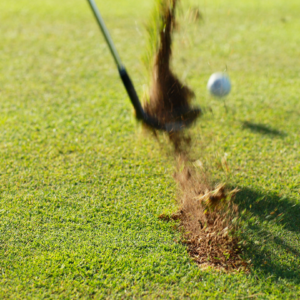Sometimes the information you need to improve as a golfer is staring you straight in the face. This information not only includes how the ball flies. But the other factual evidence that is right in front of you after making any swing. Whether playing McLemore Golf Course or anywhere else in the world, let’s call the evidence you discover after every swing, “golf swing feedback.”
Understanding what golf swing feedback is and what it provides you can make a massive difference in your overall game. As well as determining how to refine existing practice habits. Or plan new practice routines into your personal improvement plan. To do so, you must know how to read and interpret golf swing feedback. And understand a simple priority system to do so. That is what this blog post is all about.
What is Golf Swing Feedback?
Understand the definition of feedback first; information gained about your performance and used as a basis for improvement.
Technology is driving the feedback bus the past 20+ years, with FlightScope and other ball flight platforms leading the way. But the numbers this technology produces can be overwhelming to the hobbyist. And if you can’t afford the technology, you’re back to square one. What is Golf Swing Feedback?
Information In Front Of You
There is absolute and factual evidence provided you with every swing golf swing you perform. Forensic science this is not. But understanding the breadcrumbs left behind by each golf swing is what it takes to really make a big difference in your game.
Most golfers want to read the breadcrumbs as the swing is being made. I’d suggest your golf swing feedback priority system start by reading the crumbs backwards. Why? Because you must know exactly how the ball is flying and work backwards to impact. Then backwards to the various parts of your swing. And then finally backwards to your set up positions, to truly know how to diagnosis your swing. Using a “backwards” system of diagnostics is the best way to enhance your golf swing feedback knowledge and in turn, apply your findings to improving your golf skill improvement plan.
What are the Clues You Should be Looking For?
There are a few specific things you must educate yourself about to understand golf swing feedback. And become a better skilled golfer. The items I list below are intended to be a “beginners’ course” in what to look for, identify, and learn from. Believe me, we can take a massively deep dive into each of these points and others. But for this blog post, I’m trying to keep it simple for you.
8 Golf Swing Feedback Items
- Ball flight – The #1 golf swing feedback tool. This is what it all boils down to, how your golf ball flies. But what is more important is the overall tendency of ball flight. Attempting to fix anomalies is not in your best interest. Understanding trends is easier to understand and in turn, easier to predict.
- Where Did the Ball Start? – Having the answer to this one question will greatly enhance your ability to predict the direction of the club face at impact. Odds are if the ball starts left, the club face was pointing left at impact. Vice versa for the ball starting to the right.
- How did the Ball Curve? – Golf Balls curve based upon the club face position, relative to the directional path the golf club was traveling in when impact was made. Left to right curvature is most likely the result of a club path heading to the left of the ball at impact, with a club face pointing right of the club path. The opposite is true or a ball traveling right to left. No matter which side of the ball you play from.
- Did the Ball Fly Low or High? – The trajectory and height of the ball flight is an indication of where the ball was struck. And how much loft was present at the time of impact (Effective Loft).
- Strike with the Ground – Did the Club strike the ground?
- Before hitting the golf ball
- At the same time as hitting the golf ball
- After hitting the golf ball
- Or not hit the ground at all
- Strike with the Face – Did the golf ball strike:
- Strike the Center of the Club Face?
- High or Low on the Club Face?
- Left or Right of Center of the Club Face?
- Club Face Direction – At the moment of impact, was the club face pointing:

- Right at the time of impact?
- Left at the time of impact?
- Or straight at the time of impact?
- Divot – Looking from behind the divot, is the divot:
- Deep or Shallow? This is an indication of the angle of attack, the angle the club is at when approaching the golf ball.
- Slanted in one direction or the other in relation to the target line? This is an indication of the direction the club path was moving in when approaching the ball.
- Deeper to one side of the divot or the other? This will tell you if the lie angle of your clubs is too flat or too upright.
- Short or Long? This will tell you how you are releasing the club, early, on time, or late.
- Is there a divot? Tom Kite played most of his career making very few divots. But for the average player, no divot could mean you’re releasing the club very early to get the ball to fly. Or having other issues in your swing.
- Balance – How did you feel throughout the swing? Were you:
- On your toes the entire swing?
- On your heels the entire swing?
- Were you able to finish your swing without falling over? And hold your finish position until the ball landed?
- All of the above can indicate an issue with where the ball is in relation to where you are setting up; too close, too far away; or in a well-balanced position.
- Grip – Where are the “wear” patterns in the glove? Did your hands feel too loose or too tight as you swung? Are your forearms or wrists always sore after playing? All these questions and others can indicate how a poor grip influences your ball flight.
- Statistics – Taking 5 minutes to record your round in s statistical fashion will provide you a deeper insight into your game. Whether manually entering the statistics or using an automated platform such as Arccos, statistics are the glue between performance and improving performance. Knowing your tendencies of where you miss shots. What clubs you miss most often with. And a host of other items important to understand where you can spend time at practice making the most out of each practice session.
These are the main items to learn to understand golf swing feedback. There are others, but if you stick with these, you can’t go wrong.
Initiating Adjustments as You Play
Understanding golf swing feedback is one thing. Adjusting mid round because of feedback is another Making any attempt to alter your set up or “change” your swing in the middle of a round of golf is challenging at best, dangerous at worst. If you’re an average golfer, my suggestion is to accumulate the feedback over the course of the entire round, or several rounds, to create “averages.” Then from the averages, plan at least one, if not 2 practice sessions that address the average that can make the biggest difference in your performance, and your scores.
By the way, trying to change your swing mid round can be done. However, if your swing is not highly skilled, any changes made to a swing might create an even worse problem. Opt for adjusting set up positions first in the middle of a golf round. As well as during practice sessions. Seek the help of a highly experienced coach, such as John Hughes Golf, to help you understand golf swing feedback and how to make these set up adjustments.
I Can do this On My Own
But if you must make your own adjustments, here are a few important ideals to follow:
- Be objective – It’s hard to be objective when you are evaluating you. Playing and evaluating golf swing feedback objectively is sometimes hard for the best in the world. If you’re having a bad day, throw objectivity out the window. In any case, take a step back and look at your swing from an evidentiary and technical standpoint. Doing so can lead to you improving performance mid-round without making major changes.
- Be Patient – It takes time to improve your golf swing. Don’t expect to see results overnight. Just keep practicing, listening, and watching your golf swing feedback. With time, you’ll eventually experience improvement.
- Listen to the People You Employ – If you’ve hired a coach to assist you, listen and learn. You may not fully agree with everything you are hearing. But a great coach will fully understand golf swing feedback and be able to communicate what your swing feedback is providing you both. And in turn, educating you. And directly showing what you should be focused upon within your improvement plan.
- Practice what You Learn – Once you identify the areas of your swing that need improvement, practice those areas. The more you practice, the better you’ll become from a skill standpoint. And the more you’ll learn from your golf swing feedback.
- Use Tools and Aids – You do not have to own a FlightScope. But if you can afford one, I highly recommend you do so. It can provide you with a significant amount of objective feedback. Allowing you to choose one or 2 ball flight parameters to focus upon. However, if you don’t have a FlightScope, then you probably should be investing in foot powder or a sharpie. Spraying the powder on your club, or using the sharpie to paint the club face, can assist you with understanding exactly where on the face the ball is being struck. You can also use club covers, tees, empty range baskets, and other within reach items to help you improve club path, angle of attack, low point consistency, and a host of other important parts of your golf swing.
Conclusion
Golf Swing Feedback is important. It is the evidence left behind every shot that allows you to learn from mistakes and well played shots.
Using tools and being patient with yourself to understand some simple yet very important golf swing feedback elements will go a long way to your sustainable skill improvement. And you should not be shy with practice time. Understanding golf swing feedback and employing what you are learning at the practice area is the lynch pin to carrying your practice skills to the course. And using the services of a great coach, like John Hughes Golf, can make the difference of you thoroughly understand golf swing feedback.

